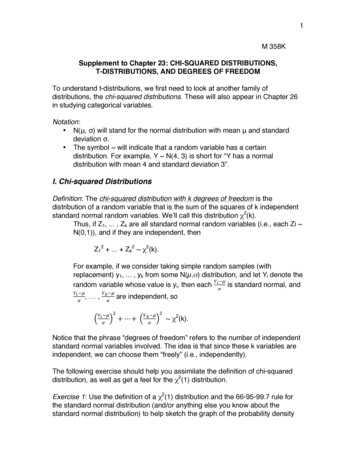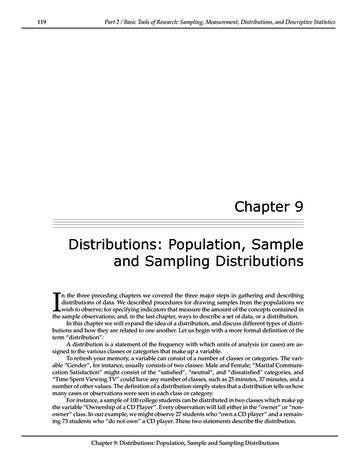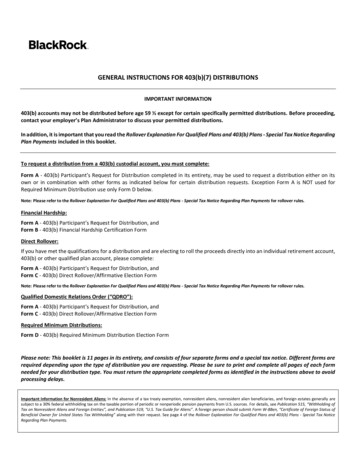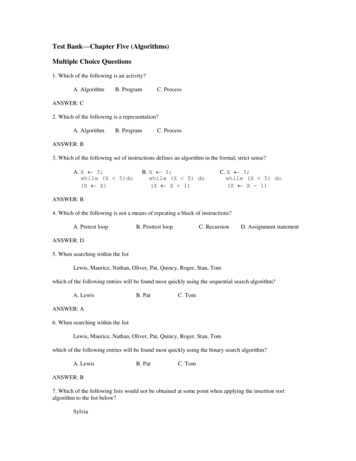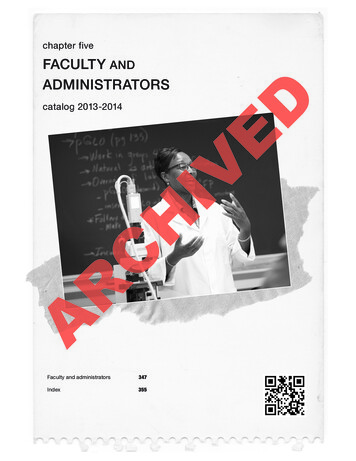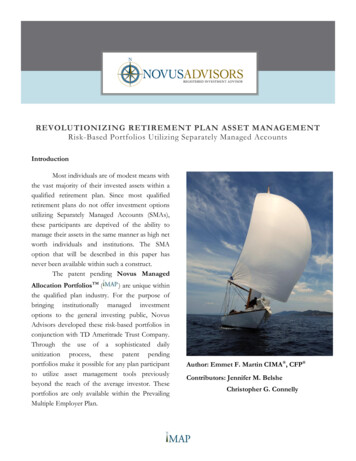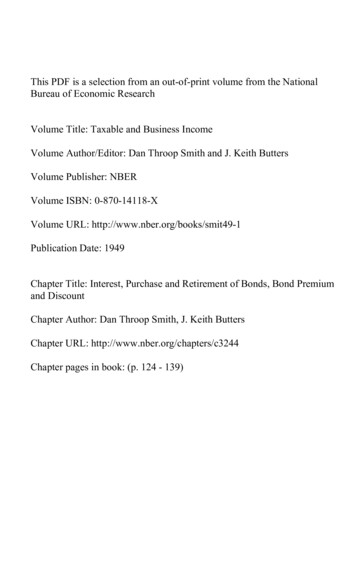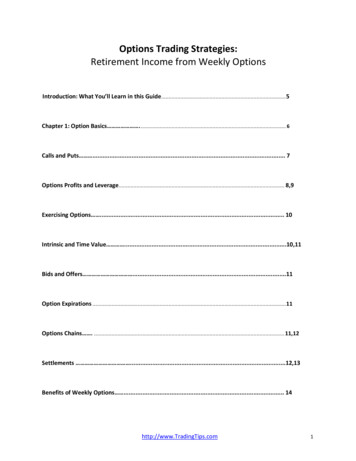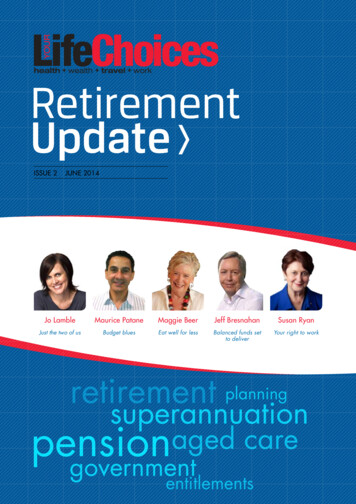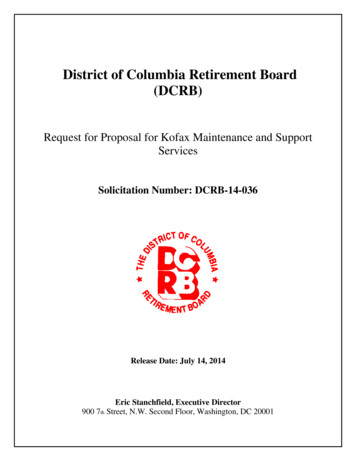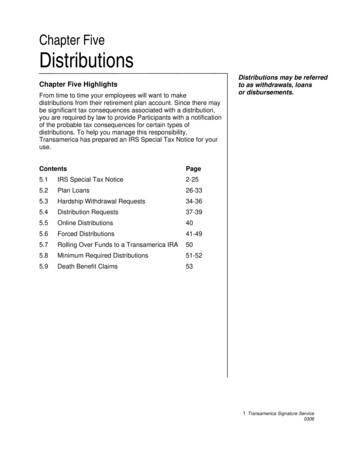
Transcription
Chapter FiveDistributionsChapter Five HighlightsFrom time to time your employees will want to makedistributions from their retirement plan account. Since there maybe significant tax consequences associated with a distribution,you are required by law to provide Participants with a notificationof the probable tax consequences for certain types ofdistributions. To help you manage this responsibility,Transamerica has prepared an IRS Special Tax Notice for youruse.ContentsPage5.1IRS Special Tax Notice2-255.2Plan Loans26-335.3Hardship Withdrawal Requests34-365.4Distribution Requests37-395.5Online Distributions405.6Forced Distributions41-495.7Rolling Over Funds to a Transamerica IRA505.8Minimum Required Distributions51-525.9Death Benefit Claims53Distributions may be referredto as withdrawals, loansor disbursements.1 Transamerica Signature Service0306
5.1 IRS SPECIAL TAX NOTICERequired Distribution and Withdrawal NoticesYou are required by the IRS to provide a written"Explanation of Special Tax Rules on Distributions" (exceptfor loans and corrective distributions resulting from testing)for each Participant or Beneficiary requesting a distributionor withdrawal of funds from your company's plan. You canfind this document on pages 4–12 of this chapter.Additionally, you may be required to supply the "Explanationof Automatic Annuity upon Distribution" and "Explanation ofQualified Pre-Retirement Survivor Annuity," depending onwhich distribution options are contained in your PlanDocument.The IRS Special Tax Noticemust accompany alldistribution request formsgiven to Participants orbeneficiaries. If you have anyquestions on any of theenclosed material, pleasecontact your AccountExecutive.Please do the following:1. Inform Participants that they have a 30-dayDecision Period—You are legally required by the IRSto give Participants 30-days to consider whether or notto elect a Direct Rollover. This waiting period beginsupon the Participant's receipt of the IRS Special TaxNotice. Participants may receive distributions prior to the30-day period as long as they make an affirmativeelection to do so and they are fully aware that they areentitled to the 30-day period to make their decision.2. Withholding Tax for Certain DistributionsοDistributions greater than 200 which arereceived in cash are subject to a mandatory 20%federal income tax withholding. TransamericaRetirement Services withholds this percentageand sends it to the IRS.οDistributions that are rolled over directly into anIRA or another qualified plan are not subject tothe mandatory withholding tax.οParticipants, surviving spouses and spousalalternate payees (payees entitled to benefitspursuant to a Qualified Domestic RelationsOrder), receiving such distributions must receivetimely notification of these requirements toenable them to make an informed election priorto the actual distribution.ο Failure to provide proper and timely notificationcould result in disqualification of the plan.2 Transamerica Signature Service0306
5.1 DISTRIBUTION INFORMATION PACKAGEUsing the IRS Model LanguageThe IRS has provided model language for the notice to planParticipants and other recipients eligible for a rolloverdistribution. We have prepared the enclosed IRS SpecialTax Notice from the IRS model.Failure to provide Participants withproper and timely notifications forplan distributions could result inplan disqualification.3 Transamerica Signature Service0306
SPECIAL TAX NOTICE REGARDING PAYMENTS FROM QUALIFIED PLANS Excerptedfrom IRS Notice 2002-3 & WRITTEN EXPLANATION OF QUALIFIED JOINT SURVIVORANNUITIES AND QUALIFIED PRE-RETIREMENT SURVIVOR ANNUITIESSpecial Tax Notice Regarding Plan PaymentsThis notice explains how you can continue to defer federal income tax on your retirementsavings in your Employer’s Plan (the "Plan") and contains important information you will needbefore you decide how to receive your Plan benefits.This notice is provided to you by your Plan Administrator because all or part of the payment thatyou will soon receive from the Plan may be eligible for rollover by you or your Plan Administratorto a traditional IRA or an eligible employer plan. A rollover is a payment by you or the PlanAdministrator of all or part of your benefit to another plan or IRA that allows you to continue topostpone taxation of that benefit until it is paid to you. Your payment cannot be rolled over to aRoth IRA, a SIMPLE IRA, or a Coverdell Education Savings Account (formerly known as aneducation IRA). An "eligible employer plan" includes a plan qualified under section 401(a) of theInternal Revenue Code, including a 401(k) plan, profit-sharing plan, defined benefit plan, stockbonus plan, and money purchase plan; a section 403(a) annuity plan; a section 403(b) taxsheltered annuity; and an eligible section 457(b) plan maintained by a governmental employer(governmental 457 plan).An eligible employer plan is not legally required to accept a rollover. Before you decide to rollover your payment to another employer plan, you should find out whether the plan acceptsrollovers and, if so, the types of distributions it accepts as a rollover. You should also find outabout any documents that are required to be completed before the receiving plan will accept arollover. Even if a plan accepts rollovers, it might not accept rollovers of certain types ofdistributions, such as after-tax amounts. If this is the case, and your distribution includes aftertax amounts, you may wish instead to roll your distribution over to a traditional IRA or split yourrollover amount between the employer plan in which you will participate and a traditional IRA. Ifan employer plan accepts your rollover, the plan may restrict subsequent distributions of therollover amount or may require your spouse's consent for any subsequent distribution. Asubsequent distribution from the plan that accepts your rollover may also be subject to differenttax treatment than distributions from this Plan. Check with the administrator of the plan that is toreceive your rollover prior to making the rollover.If you have additional questions after reading this notice, you can contact your PlanAdministrator.SummaryThere are two ways you may be able to receive a Plan payment that is eligible for rollover:1. Certain payments can be made directly to a traditional IRA that you establish or to aneligible employer plan that will accept it and hold it for your benefit ("DIRECTROLLOVER"); or2. The payment can be PAID TO YOU.A. If you choose a DIRECT ROLLOVER:4 Transamerica Signature Service0306
οYour payment will not be taxed in the current year and no income tax will bewithheld.οYou choose whether your payment will be made directly to your traditional IRA orto an eligible employer plan that accepts your rollover. Your payment cannot berolled over to a Roth IRA, a SIMPLE IRA, or a Coverdell Education SavingsAccount because these are not traditional IRAs.The taxable portion of your payment will be taxed later when you take it out of thetraditional IRA or the eligible employer plan. Depending on the type of plan, thelater distribution may be subject to different tax treatment than it would be if youreceived a taxable distribution from this Plan.οB. If you choose to have a Plan payment that is eligible for rollover PAIDTO YOU:οοοοYou will receive only 80% of the taxable amount of the payment, because thePlan Administrator is required to withhold 20% of that amount and send it to theIRS as income tax withholding to be credited against your taxes.The taxable amount of your payment will be taxed in the current year unless youroll it over. Under limited circumstances, you may be able to use special tax rulesthat could reduce the tax you owe. However, if you receive the payment beforeage 59 1/2, you may have to pay an additional 10% tax.You can roll over all or part of the payment by paying it to your traditional IRA orto an eligible employer plan that accepts your rollover within 60 days after youreceive the payment. The amount rolled over will not be taxed until you take it outof the traditional IRA or the eligible employer plan.If you want to roll over 100% of the payment to a traditional IRA or an eligibleemployer plan, you must find other money to replace the 20% of the taxableportion that was withheld. If you roll over only the 80% that you received, you willbe taxed on the 20% that was withheld and that is not rolled over.Your Right to Waive the 30-Day Notice Period.Generally, neither a direct rollover nor a payment can be made from the plan until at least 30days after your receipt of this notice. Thus, after receiving this notice, you have at least 30 daysto consider whether or not to have your withdrawal directly rolled over. If you do not wish to waituntil this 30-day notice period ends before your election is processed, you may waive the noticeperiod by making an affirmative election indicating whether or not you wish to make a directrollover. Your withdrawal will then be processed in accordance with your election as soon aspractical after it is received by the Plan Administrator.5 Transamerica Signature Service0306
MORE INFORMATIONI.II.III.IV.Payments that can and cannot be rolled overDirect RolloverPayment paid to youSurviving spouses, alternate payees, and other beneficiariesI.PAYMENTS THAT CAN AND CANNOT BE ROLLED OVERPayments from the Plan may be "eligible rollover distributions." This means that they canbe rolled over to a traditional IRA or to an eligible employer plan that accepts rollovers.Payments from a plan cannot be rolled over to a Roth IRA, a SIMPLE IRA, or a CoverdellEducation Savings Account. Your Plan Administrator should be able to tell you whatportion of your payment is an eligible rollover distribution.After-tax Contributions. If the Plan allowed and you made after-tax contributions, thesecontributions may be rolled into either a traditional IRA or to certain employer plans thataccept rollovers of the after-tax contributions. The following rules apply:a. Rollover into a Traditional IRA. You can roll over your after-tax contributions to atraditional IRA either directly or indirectly. Your Plan Administrator should be able to tellyou how much of your payment is the taxable portion and how much is the after-taxportion.If you roll over after-tax contributions to a traditional IRA, it is your responsibility to keeptrack of, and report to the Service on the applicable forms, the amount of these after-taxcontributions. This will enable the nontaxable amount of any future distributions fromthe traditional IRA to be determined.Once you roll over your after-tax contributions to a traditional IRA, those amountsCANNOT later be rolled over to an employer plan.b. Rollover into an Employer Plan. You can roll over after-tax contributions from anemployer plan that is qualified under Code section 401(a) or a section 403(a) annuityplan to another such plan using a direct rollover if the other plan provides separateaccounting for amounts rolled over, including separate accounting for the after-taxemployee contributions and earnings on those contributions. You can also roll overafter-tax contributions from a section 403(b) tax-sheltered annuity to another section403(b) tax-sheltered annuity using a direct rollover if the other tax-sheltered annuityprovides separate accounting for amounts rolled over, including separate accounting forthe after-tax employee contributions and earnings on those contributions. You CANNOTroll over after-tax contributions to a governmental 457 plan. If you want to roll over yourafter-tax contributions to an employer plan that accepts these rollovers, you cannothave the after-tax contributions paid to you first. You must instruct the PlanAdministrator of this Plan to make a direct rollover on your behalf. Also, you cannot firstroll over after-tax contributions to a traditional IRA and then roll over that amount into anemployer plan.6 Transamerica Signature Service0306
The following types of payments, if applicable to your Plan, cannot be rolled over:ο Payments Spread over Long Periods. You cannot roll over a payment if it is part of aseries of equal (or almost equal) payments that are made at least once a year and thatwill last for:1. your lifetime (or a period measured by your life expectancy), or2. your lifetime and your beneficiary's lifetime (or a period measured by your joint lifeexpectancies), or3. a period of 10 years or more.οRequired Minimum Payments. Beginning when you reach age 70 1/2 or retire,whichever is later, a certain portion of your payment cannot be rolled over because it isa "required minimum payment" that must be paid to you. Special rules apply if you own5% or more of your employer.οHardship Distributions. A hardship distribution cannot be rolled over.οESOP Dividends. Cash dividends paid to you on employer stock held in an employeestock ownership plan cannot be rolled over.οCorrective Distributions. A distribution that is made to correct a failednondiscrimination test or because legal limits on certain contributions were exceededcannot be rolled over.οLoans Treated as Distributions. The amount of a plan loan that becomes a taxabledeemed distribution because of a default cannot be rolled over. However, a loan offsetamount is eligible for rollover, as discussed in Part III below. Ask the PlanAdministrator of this Plan if distribution of your loan qualifies for rollover treatment.The Plan Administrator of this Plan should be able to tell you if your payment includesamounts which cannot be rolled over.II.DIRECT ROLLOVERA DIRECT ROLLOVER is a direct payment of the amount of your Plan benefits to atraditional IRA or an eligible employer plan that will accept it. You can choose a DIRECTROLLOVER of all or any portion of your payment that is an eligible rollover distribution, asdescribed in Part I above. You are not taxed on any taxable portion of your payment forwhich you choose a DIRECT ROLLOVER until you later take it out of the traditional IRA oreligible employer plan. In addition, no income tax withholding is required for any taxableportion of your Plan benefits for which you choose a DIRECT ROLLOVER. This Planmight not let you choose a DIRECT ROLLOVER if your distributions for the year are lessthan 200.οDIRECT ROLLOVER to a Traditional IRA. You can open a traditional IRA to receivethe direct rollover. If you choose to have your payment made directly to a traditionalIRA, contact an IRA sponsor (usually a financial institution) to find out how to haveyour payment made in a direct rollover to a traditional IRA at that institution. If you areunsure of how to invest your money, you can temporarily establish a traditional IRA to7 Transamerica Signature Service0306
receive the payment. However, in choosing a traditional IRA, you may wish to makesure that the traditional IRA you choose will allow you to move all or a part of yourpayment to another traditional IRA at a later date, without penalties or other limitations.See IRS Publication 590, Individual Retirement Arrangements, for more information ontraditional IRAs (including limits on how often you can roll over between IRAs).III.οDIRECT ROLLOVER to a Plan. If you are employed by a new employer that has aneligible employer plan, and you want a direct rollover to that plan, ask the PlanAdministrator of that plan whether it will accept your rollover. An eligible employer planis not legally required to accept a rollover. Even if your new employer's plan does notaccept a rollover, you can choose a DIRECT ROLLOVER to a traditional IRA. If theemployer plan accepts your rollover, the plan may provide restrictions on thecircumstances under which you may later receive a distribution of the rollover amountor may require spousal consent to any subsequent distribution. Check with the PlanAdministrator of that plan before making your decision.οDIRECT ROLLOVER of a Series of Payments. If you receive a payment that can berolled over to a traditional IRA or an eligible employer plan that will accept it, and it ispaid in a series of payments for less than 10 years, your choice to make or not make aDIRECT ROLLOVER for a payment will apply to all later payments in the series untilyou change your election. You are free to change your election for any later paymentin the series.οChange in Tax Treatment Resulting from a DIRECT ROLLOVER. The tax treatmentof any payment from the eligible employer plan or traditional IRA receiving yourDIRECT ROLLOVER might be different than if you received your benefit in a taxabledistribution directly from the Plan. For example, if you were born before January 1,1936, you might be entitled to ten-year averaging or capital gain treatment, asexplained below. However, if you have your benefit rolled over to a section 403(b) taxsheltered annuity, a governmental 457 plan, or a traditional IRA in a DIRECTROLLOVER, your benefit will no longer be eligible for that special treatment. See thesections below entitled "Additional 10% Tax if You Are under Age 59 1/2" and "SpecialTax Treatment if You Were Born before January 1, 1936."PAYMENT PAID TO YOUIf your payment can be rolled over (see Part I above) and the payment is made to you incash, it is subject to 20% federal income tax withholding on the taxable portion (state taxwithholding may also apply). The payment is taxed in the year you receive it unless, within60 days, you roll it over to a traditional IRA or an eligible employer plan that acceptsrollovers. If you do not roll it over, special tax rules may apply.οIncome Tax Withholding:οMandatory Withholding. If any portion of your payment can be rolled over under Part Iabove and you do not elect to make a DIRECT ROLLOVER, the Plan is required by lawto withhold 20% of the taxable amount. This amount is sent to the IRS as federal incometax withholding. For example, if you can roll over a taxable payment of 10,000, only 8,000 will be paid to you because the Plan must withhold 2,000 as income tax.8 Transamerica Signature Service0306
However, when you prepare your income tax return for the year, unless you make arollover within 60 days (see "Sixty-Day Rollover Option" below), you must report the full 10,000 as a taxable payment from the Plan. You must report the 2,000 as taxwithheld, and it will be credited against any income tax you owe for the year. There willbe no income tax withholding if your payments for the year are less than 200.οVoluntary Withholding. If any portion of your payment is taxable but cannot be rolledover under Part I above, the mandatory withholding rules described above do not apply.In this case, you may elect not to have withholding apply to that portion. If you donothing, 10% will be taken out of this portion of your payment for federal income taxwithholding. To elect out of withholding, ask the Plan Administrator for the election formand related information.οSixty-Day Rollover Option. If you receive a payment that can be rolled over under PartI above, you can still decide to roll over all or part of it to a traditional IRA or to an eligibleemployer plan that accepts rollovers. If you decide to roll over, you must contribute theamount of the payment you received to a traditional IRA or eligible employer plan within60 days after you receive the payment. The portion of your payment that is rolled overwill not be taxed until you take it out of the traditional IRA or the eligible employer plan.You can roll over up to 100% of your payment that can be rolled over under Part I above,including an amount equal to the 20% of the taxable portion that was withheld. If youchoose to roll over 100%, you must find other money within the 60-day period tocontribute to the traditional IRA or the eligible employer plan, to replace the 20% thatwas withheld. On the other hand, if you roll over only the 80% of the taxable portion thatyou received, you will be taxed on the 20% that was withheld.Example: The taxable portion of your payment that c
1 Transamerica Signature Service 0306 Chapter Five Distributions Chapter Five Highlights From time to time your employees will want
